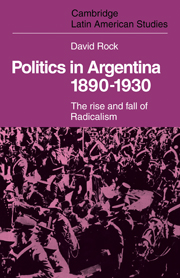Book contents
- Frontmatter
- Contents
- Preface
- 1 The components of Argentine society, 1890–1914
- 2 The oligarchy and institutional reform, 1880–1916
- 3 The rise of Radicalism, 1891–1916
- 4 The workers and their politics in Buenos Aires, 1890–1916
- 5 The first Radical government, 1916–22
- 6 The strikes, 1916–18
- 7 The Semana Trágica
- 8 1919
- 9 Postscript to the first presidency, 1920–2
- 10 The Alvear interlude, 1922–8
- 11 Yrigoyen's second presidency, 1928–30
- 12 Perspectives
- APPENDIXES
- 1 The occupational and class structure of the male population of the city of Buenos Aires by nationality, 1914
- 2 The rise of Radicalism – an historiographical note
- 3 The first Radical government and the Argentine Rural Society
- 4 The working class vote for the Radical and yrigoyenista parties in selected areas of Buenos Aires, 1912–30
- Select bibliography
- Index
5 - The first Radical government, 1916–22
Published online by Cambridge University Press: 04 August 2010
- Frontmatter
- Contents
- Preface
- 1 The components of Argentine society, 1890–1914
- 2 The oligarchy and institutional reform, 1880–1916
- 3 The rise of Radicalism, 1891–1916
- 4 The workers and their politics in Buenos Aires, 1890–1916
- 5 The first Radical government, 1916–22
- 6 The strikes, 1916–18
- 7 The Semana Trágica
- 8 1919
- 9 Postscript to the first presidency, 1920–2
- 10 The Alvear interlude, 1922–8
- 11 Yrigoyen's second presidency, 1928–30
- 12 Perspectives
- APPENDIXES
- 1 The occupational and class structure of the male population of the city of Buenos Aires by nationality, 1914
- 2 The rise of Radicalism – an historiographical note
- 3 The first Radical government and the Argentine Rural Society
- 4 The working class vote for the Radical and yrigoyenista parties in selected areas of Buenos Aires, 1912–30
- Select bibliography
- Index
Summary
The general course of Argentine politics after 1916 was shaped by the relationship between successive Radical governments and the conservative elite groups which they replaced. The election victory won by the Radicals in 1916 appeared initially a reflection of the capacity of the traditional ruling class for retrenchment and self-preservation. Although the original objective of creating a majoritarian conservative party along the lines laid down by Pellegrini and Sáenz Peña had failed, and direct control over the administration had passed into new hands, there was no reason to believe that the real power of the elite had disappeared or diminished in any significant way. The army and navy had the same commanders as before 1916. The major lobby associations representing the elite's interests, such as the Sociedad Rural, were still intact. Also, powerful members of the elite still retained their positions of close contact with the foreign business groups.
The Radical government in 1916
In many respects the oligarchy appeared to have merely changed its form. In Yrigoyen's first cabinet in 1916, five out of the eight ministers were either cattle-owning landowners in the province of Buenos Aires or closely connected with the export sector. The minister of finance was Domingo E. Salaberry, who was involved in exporting, banking and real estate. The minister of agriculture, who later became minister of foreign affairs, was Honorio Pueyrredón, a major landowner and patrician from the province of Buenos Aires.
- Type
- Chapter
- Information
- Politics in Argentina, 1890–1930The Rise and Fall of Radicalism, pp. 95 - 124Publisher: Cambridge University PressPrint publication year: 1975

